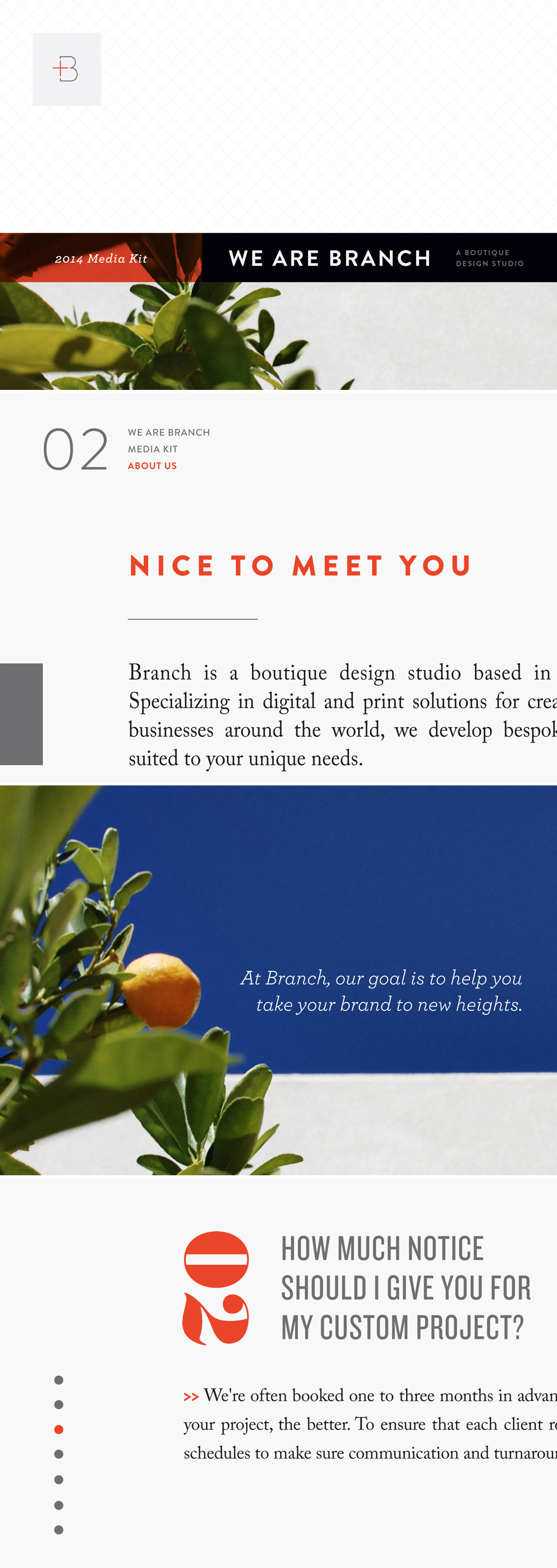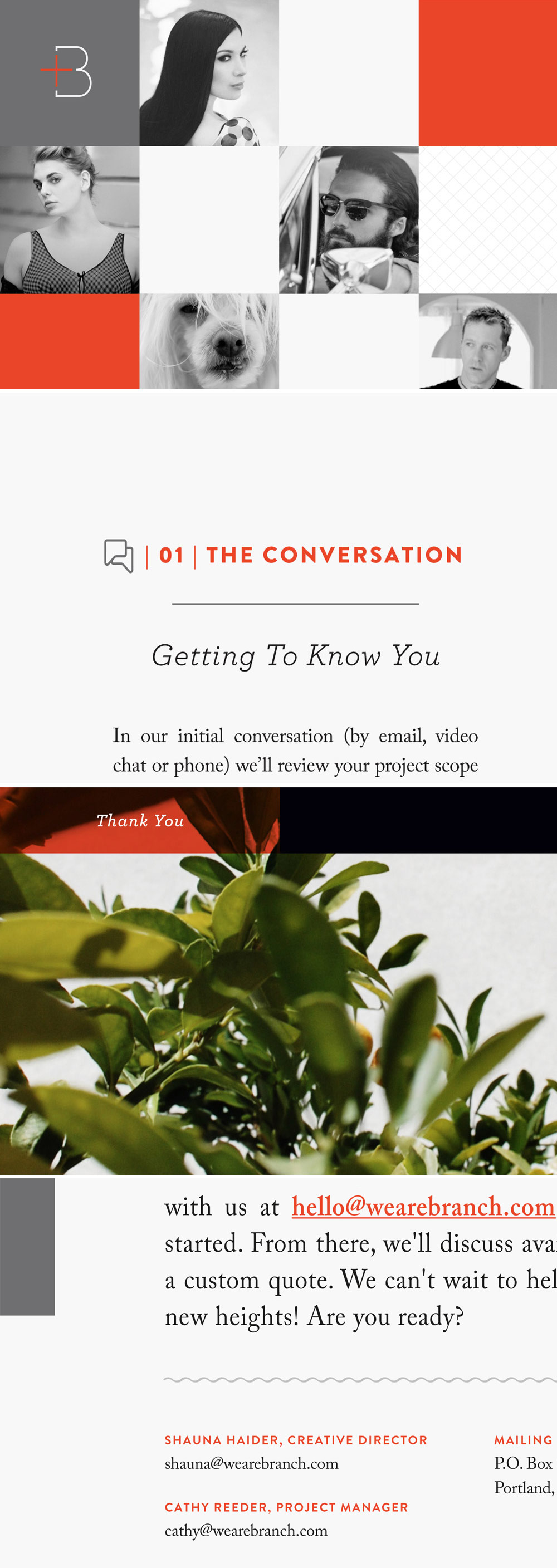Over the last few years, media kits have moved from the more traditional worlds of print magazines and corporations to become a key sales tool for bloggers and small businesses.
If you’re not familiar with a media kit, it’s basically a multi-page document that businesses use to promote themselves and sell their services to potential clients. Magazines use media kits to sell spots to advertisers (Elle, Fast Company, Entrepreneur and many others make theirs public), bloggers use media kits to sell ads, sponsored posts and brand collaborations and service-based businesses like photographers use media kits to promote their packages.
The Branch Media Kit
On the surface, media kits come across as very open-ended and a little difficult to nail down but that’s part of their appeal. There is no set formula — a media kit can promote whatever areas a business feels are most important! And, media kits can be set up as PDF documents or built into their own subdomain (like New York Magazine.) At Branch, our clients prefer a PDF document because it can easily be printed out for in-person meetings (and mimic a mini magazine) or attached to email correspondence.
To be completely honest, I didn’t even know that media kits existed until 2007 when a print magazine hired me to create theirs. I built that first media kit from scratch and the second it hit my portfolio, bloggers started asking for their own versions. Since then, I’ve done dozens of media kits for clients including accessory designers, burlesque performers, wedding photographers and more. In some form or another, every small business needs a media kit. Naturally, that would include Branch but they always say that as designers, we are our own most difficult clients! It’s always easier to take on paid client work than to stop, ask yourself the difficult questions including why what you do matters, what makes your offerings different and how your process guarantees stellar results. But with Branch now three months old, I knew it was time to get serious and put together a media kit tailored to the types of clients we wanted to appeal to (creative small businesses).
Our media kit clocks in at 16 pages and covers everything from who we are to detailed outlines of our services and processes. Having everything in one document has cut down on email correspondence tremendously. We used to send out a price sheet and process sheet separately and then answered a lot of the same questions about timelines. Now, we attach a single PDF that includes all of that information (and much more). A media kit not only provides a more professional experience but it also shows that you care — you’ve already considered all the ins and outs of what a new client would want to know and made sure they’re well informed.
Some businesses make their media kits public but others like Branch only offer them on request. Our media kit is designed to be client-facing and we strive to build personal relationships. When we have a conversation going, it’s easier to make sure our media kit is doing its job and that all questions are answered. When it comes to your media kit, you’ll have to decide whether having it public or private will serve your business best.
What Goes Into A Media Kit?
If you’re looking for ideas on what to include in your media kit, most have a combination of the following information:
1. An introduction to yourself and your business
This is your chance to explain who you are, what you do and what purpose your business serves. Of course, this is easier said than done. Writing about ourselves and playing up our accomplishments can be incredibly difficult — if you’re getting caught up on writing out your professional bio, don’t be afraid to hire a copywriter. An outside source can view you more objectively and pull together your highlights without that layer of self-consciousness.
2. Your mission
Sometimes known as a manifesto, this is your way of differentiating your business from the competition and explaining what it stands for. Differentiation is particularly important because customers have so many choices of who they can choose to work with and after awhile, it feels like a blur. Differentiation is about not being afraid to be unique and when it comes to small businesses, unique is good!
3. Testimonials
There’s only so much you can say about how wonderful you are before you sound incredibly full of yourself! That’s where testimonials come in. Whether they’re from readers, advertisers or clients, testimonials add a sense of credibility to your business. Potential clients want to know why it’s a safe bet to book with you. I used to dread testimonials but with Branch, I got over those fears and we now have two pages’ worth in our media kit.
4. Frequently asked questions
If you find yourself repeatedly getting asked the same exact questions, stop and take note! Having a FAQ in your media kit can alleviate some of the basic email banter that comes with new inquiries.
5. List of notable clients
Remember, a lot of your potential clients have never worked with someone in your industry before. They want to know that they’re making a sound decision and if they don’t have any mutual friends that have worked with you, the next best thing is a lit of clients who’ve taken the leap.
6. Services offered
Are there specific types of projects that you enjoy doing? Highlight them! We love a few things that are a little less common including editorial design and media kits so we make a special mention of those, along with the usual web design and branding.
7. Packages and rates
If you’re not great at talking about money, clearly listing your services with base-level pricing and an outline of what the client receives makes it clear from the beginning what the investment is to work with you (we always say “starting at” and then provide a custom quote when they’re ready). Never surprise anyone when it comes to money — be upfront right out of the gate so your client can make an informed decision.
8.Stats (if applicable)
If you’re offering a service where your stats are of particular importance, include your blog / site numbers along with social media stats. If you can go one step further and do a reader / customer survey and include the best findings from that as well, it will add to your credibility.
9. Processes
Do you have a process you follow every single time? Designers and photographers usually have a specific set of steps they’ve honed to deliver a consistent outcome and a media kit is a great place to list them so customers understand what goes into your work (and that this behind-the-scenes work contributes to the rates!)
10. Contact information
The back page of your media kit should include clear instructions about how to get in touch with you! We include full names and emails along with our mailing address. We’ll have a dedicated phone number once our new office is up and running next year. Make it as easy as possible for people book you!
In Closing
When it comes to media kits, small businesses put them off because they’re a huge investment in both time and money. But time and again, I’ve watched small businesses make that investment back in an incredibly short period of time because their media kit made clients feel more comfortable about booking their services and the more they booked, the more quickly they were able to bump up their rates. If you invest in your business in smart ways, that investment comes full circle through clients who respect what you do and are willing to pay for it. In a way, media kits are a small businesses’ best friend because they convey a level of professionalism and information on your behalf when you can’t be there in person. And that is more than worth it. -Shauna



